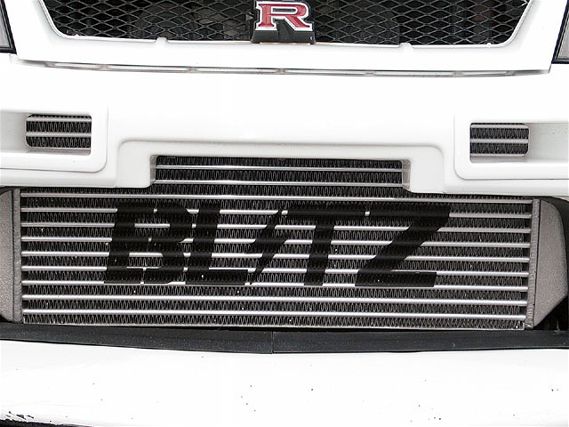 | Nissan Skyline GT-R Boost-Up - Blitz Front-Mount Intercooler
| Nissan Skyline GT-R Boost-Up - Blitz Front-Mount Intercooler In Part 1 of Power Upgrades for the R33 Skyline GT-R (August '03), we were able to generate 331.5 hp and 299.4 lb-ft of torque to the wheels (41.9 hp and 46.2 lb-ft of torque) from three basic bolt-ons (exhaust, air filter and downpipe) over the stock baseline. Although the owner of the vehicle was impressed with the power increases, it didn't take him long to come back for more. This time around the owner brought with him a Blitz front-mount intercooler upgrade and Blitz SBC I-D boost controller.
With the racing heritage of the Skyline GT-R it would be a crime to leave the Nissan stock. As mentioned in the previous article, the factory RB26DETT is highly over-engineered and many examples have been pushed to more than 600 hp to the wheels.
Without hesitation, we wired up the Blitz Dual SBC I-D boost controller. Since the Skyline runs two turbos, the signal to the factory boost actuator must be intercepted from both turbos or else one turbo will produce more boost than the other. The signal to the actuators are T'd and routed into the Blitz boost solenoid. Unlike some of the competitor boost solenoids, the Blitz unit utilizes two solenoids, enabling the boost controller to work more effectively. By having two solenoids to bleed off boost pressure, the solenoids can stay closed for a longer time to increase turbo response resulting in more power at the lower engine speeds.
After installing the Blitz boost controller, it was off to XS Engineering's Dynamic Test Systems 4WD dyno. With the boost controller turned off and the RB26 running factory boost, the GT-R registered 340.2 hp and 260.1 lb-ft of torque at 9 psi of boost pressure. With the boost pressure set at 0.91 bar (13.4 psi), the horsepower line arced to 397.0 hp while torque skyrocketed to 358.3 lb-ft, nearly a 100 lb-ft of torque increase!
By changing the gain setting on the SBC I-D, we were able to gain more power at lower engine speeds but it didn't change the overall peak horsepower since max boost was still limited to 0.91 bar. However, if the gain setting is set too high, a spike might occur, thereby over-shooting the ideal set boost pressure. It is always important to monitor air/fuel ratio when tuning a boost controller, making sure there's a sufficient amount of fuel to go with the extra boost pressure. Also, we hooked up a knock monitor to listen for any signs of detonation.
On the dyno and after a couple of pulls, the factory front-mount intercooler would become heat soaked and thereby throwing off the power figures. We pulled off the front bumper cover and found out that although the GT-R's intercooler is fairly long, it's not very thick.
When compared to the Blitz front-mount replacement, the factory GT-R was lacking in size. The Blitz unit measured 4 inches thick, while the factory unit was about 2.5 inches. The Blitz cooler was also slightly taller than the stock piece. Mounting the Blitz cooler was a straight RR affair with the stock unit coming off and the Blitz unit going in. The stock plumbing is still retained so the install was extremely simple and quick. With the Blitz chiller now in place, we were able to perform several dyno runs with consistent power figures. Also, the new Blitz cooler is shiny silver, unlike the factory black unit.
The GT-R is truly a supercar. What other car can you think of where you can gain 56.8 hp and 98.2 lb-ft of torque with one simple upgrade? For the next installment we plan to add an A'PEXi Power FC computer to push the limits of the RB26 and California's "awesome" 91-octane gas. Stay tuned for the next GT-R power infusion.
